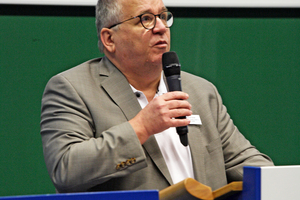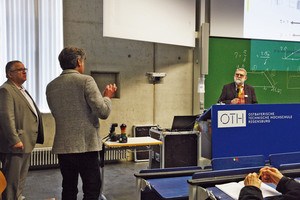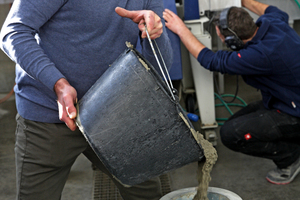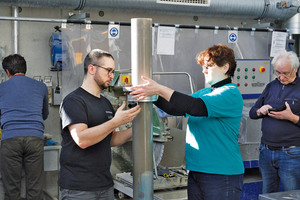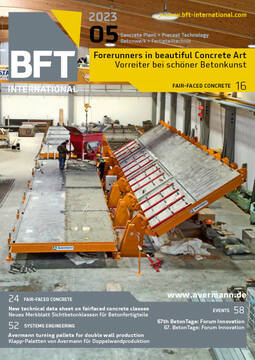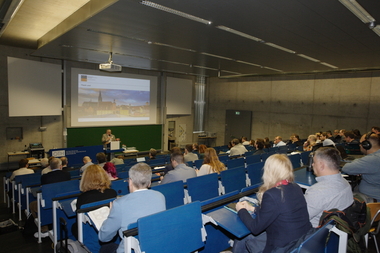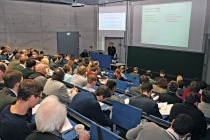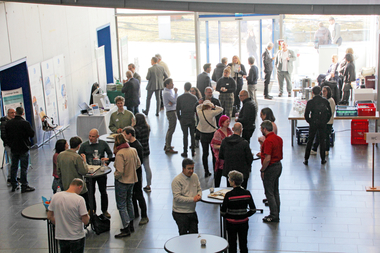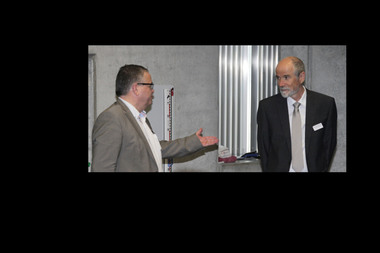OTH Regensburg hosted 32nd Rheology Conference
The 32nd edition of the rheology conference took place in Regensburg in March. Besides nine interesting short lectures, Schleibinger, the manufacturer of testing systems and devices, showcased its Sliper and eBT-V rheometers.
In early March, the Ostbayerische Technische Hochschule (OTH) in Regensburg hosted the 32nd edition of the “Panta Rhei – Everything Flows” rheology conference in cooperation with Schleibinger, the manufacturer of testing systems and devices. Rheology generally refers to the science studying the flow behavior of materials. The one-and-a-half-day conference focused primarily on determining the characteristics of liquid or viscous cements and concretes. One of the main topics was the pumpability of fresh cement and concrete slurries. When pouring concrete on the job site, for example, pumping vehicles need to be used to convey these materials from transport trucks to distant on-site destinations that are often considerably more elevated. In this process, the complex suspension must not segregate. However, it is equally important to prevent the sometimes viscous concrete mass from coming to a standstill, such as in tight bends of the pump line, since this can cause blockages.
Schleibinger Geräte Teubert u. Greim GmbH based in Buchbach, Bavaria, is one of the world’s leading manufacturers of rheological measuring instruments, so-called rheometers, and presented two of its new models at the conference. Another exhibitor was C3 Prozess- und Analysentechnik GmbH based in Haar, Bavaria, which primarily showcased melting units for the preparation of mineral test tablets.
Schleibinger Sliper – Sliding Pipe Rheometer
Schleibinger’s new Sliper rheometer model is used to determine the flow behavior of concretes and cements in pipes. It replicates a realistic pipe setup and is mobile and easy to use on the construction site. Concrete can thus be tested for its rheological characteristics immediately before it is poured.
The Sliper system consists of a vertical piston equipped with a pressure sensor on its head and a motion sensor on its jacket. A transparent plastic cylinder is placed over this piston and initially locked in its bottom position. This transparent cylinder overhangs the piston by one meter and is filled to the brim with the sample material. The cylinder is then pushed by hand into its top position, i.e. one meter higher. For measuring purposes, the cylinder is unlocked, causing it to “slide” down. During this time, both the duration of its sliding down to the bottom position and the contact pressure of the concrete mix on the top of the piston are measured. This procedure is repeated several times and the cylinder is also fitted with weights on its outside. To analyze the measured values, they are transmitted via Bluetooth to an app that can be installed on any commercially available cell phone.
Schleibinger eBT-V – Mobile rheometer for fresh concrete
The eBT-V is a mobile, electrically operated, off-grid rheometer designed for fresh concrete used for determining the flow resistance of the material. It measures the relative yield point and the relative viscosity of the tested fresh concrete. This instrument can be operated in two different modes: firstly, in P mode for conventional vibrated and relatively stiff concretes. In this case, a spherical sensor attached to a short, vertical rod is lowered into a round measuring trough filled with the test material, such as concrete, where it performs a circular motion and the required shear resistance is measured.
In V mode, on the other hand, the device uses a centrally positioned propeller consisting of radially arranged vanes. When switched on, a stirring motion is generated to measure its torque. Friction effects on the measuring trough wall are prevented by a specially developed device holder consisting of integrated anti-slip rods.
Lectures on rheology
Highlights of the conference were the presentations by Daniil Mikhalev and the lecture delivered by Dr. Dieter Bergemann, which dealt with the prediction accuracy of the Sliper rheometer referred to above. Mikhalev is conducting research at the Institute of Construction Materials at Technische Universität Dresden chaired by Prof. Viktor Mechtcherine. There, the scientists had set up a small “obstacle course” through which they pumped the fresh concrete through pipes. The characteristics of the concrete mix were documented by the Sliper prior to pumping, and the flow behavior of the material was subsequently evaluated at a pipe bend, among other points.
Dr. Bergemann’s presentation elaborated on the phenomenon of edge zone segregation in a pipe conveying system for fresh concrete.
The presentation held by Małgorzata Gołaszewska outlined the rheological properties of CSA cement mortar. In this material, calcium sulfate aluminate (CSA) serves as a mineral-based hydraulic binder.
Olivia Grindle, from Munich Technical University, investigated the workability of mortars and concretes using superplasticizers. She studied the different concrete properties when using melamine-, carboxylate- and phosphate-based superplasticizers.
Steffen Schneider, from Poro Additive GmbH in Laufen, Germany, used his presentation to address the relationship between actual particle size distribution and effective suspension viscosity. He identified numerous strong particle interactions that must be taken into account as a matter of principle.
Subhransu Dhar and Teresa Liberto, from Vienna University of Technology, presented their current research on sheared concrete slurries that contain calcium silicates and in which calcium silicate nanohydrates (C-S-H) precipitate. In their investigations, the researchers used a high-speed camera to record the flow behavior and, more specifically, the formation of shear bands, and subsequently analyzed the data using the Particle Image Velocimetry program.
The presentations were rounded off by Ana Brunčič from the National Institute of Civil Engineering in Ljubljana, Slovenia, and Teresa Liberto from Vienna University of Technology, who dealt with small amplitude oscillatory shear (SAOS) tests.
The second day of the event included a comprehensive, very informative demonstration of Schleibinger’s Sliper and eBT-V rheometers at the OTH civil engineering laboratory.
Text: Dipl.-Ing. Robert Mehl
CONTACT
Schleibinger Geräte Teubert u. Greim GmbH
Gewerbestraße 4
84428 Buchbach/Germany
+49 8086 94731-10

